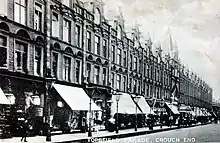
.jpg.webp)

James Edmondson (27 August 1857 – 7 June 1931), known as "the Highbury builder", was an English property developer who was responsible for the creation of the Sotheby Road area in Highbury and the development of several notable shopping parades in suburban north London. With William J. Collins, he was instrumental in the creation of modern Muswell Hill.
Early life
James Edmondson was born on 27 August 1857 in Clerkenwell, London, to Isaac Edmondson, a carpenter from Penruddock, Cumberland, and Hannah Edmondson of Westmorland. In 1881, the family were living in a sizeable house at 40 Petherton Road, at which time James was probably working in his father's business.[1][2]
Career
James at first worked with his father in his building firm. One of their first large projects was a commission with Charles Herbert Shoppe to build a parade of shops at The Broadway in Highbury Park. Their first large solo project was the development of the streets of the Sotheby Road Conservation Area in Highbury. In 1894, trading as the firm of I. Edmondson and Son Limited, they took offices at 8 The Broadway (now 86 Highbury Park). With James in the lead, they developed a formula of residential houses fronted by uniform shopping parades with flats above that they repeated in Crouch End, Muswell Hill, Golders Green, and elsewhere in London. With William J. Collins, James Edmondson was instrumental in the creation of modern Muswell Hill. He retired in 1923 and moved to Bournemouth.[1][2][3][4]
Personal life
Edmondson married Isabel (or Isabele/Isabelle) Anne (or Annie). His eldest son, Albert James Edmondson, joined the family business in the 1920s and later became a Conservative Party member of Parliament and was ennobled as a Baron Sandford in 1945.[1] Their other children were Percival H., Elsee M. and Cyril A.[5] James Edmondson was active in congregationalist circles and worshiped at the Congregational Church in Highbury Quadrant. He was a donor to other non-conformist churches and established the Dudley Lawn Tennis Club. His home was "North Holme" at 12 Aberdeen Terrace (now 52 Aberdeen Road), Highbury.[2]
Death and legacy
Edmondson died at 29 Wimpole Street, London, on 7 June 1931, leaving a widow, Isabel Anne Edmondson, and an estate of £248,170.[6] In 2013, a plaque was placed on his former offices at Highbury Park by members of the Sotheby Road Conservation Society for the London Borough of Islington.[2]
Selected developments
- Crouch End Hippodrome, Topsfield Parade.[7]
- Shopping parades in Golders Green.[1]
- Shopping parades in Muswell Hill.[1]
- Sotheby Road area, Highbury.[1]
- Topsfield Parade, Tottenham Lane, Crouch End.[8]
References
- 1 2 3 4 5 6 Recent Plaques. London Borough of Islington, 22 March 2015. Archived at WaybackMachine. Retrieved 28 December 2016.
- 1 2 3 4 New People's Plaque pays tribute to James Edmondson, the 'Highbury Builder'. Andrew Johnson, Islington Tribune, 18 October 2013. Retrieved 28 December 2016.
- ↑ London will soon become home to only the very rich and the poor. Ian Jack, The Guardian, 19 October 2013. Retrieved 29 December 2016.
- ↑ Living in Muswell Hill: area guide to homes, schools and transport. Anthea Masey, London Evening Standard, 19 February 2014. Retrieved 29 December 2016.
- ↑ James Edmonson England and Wales Census, 1901. FamilySearch. Retrieved 29 December 2016.
- ↑ 1931 Probate Calendar.. Retrieved 29 December 2016.
- ↑ "Crouch End Hippodrome – The Theatres Trust". theatrestrust.org.uk. Retrieved 28 December 2016.
- ↑ Pevsner, Nikolaus & Bridget Cherry. (2002). The Buildings of England: London 4 North. New Haven & London: Yale University Press. p. 559. ISBN 0300096534.
External links
- "10 Things You Never Knew About Muswell Hill – Articles – MyMuswell". mymuswell.com. Retrieved 29 December 2016.
- The Paul Drury Partnership (January 2010). "The Lakes Estate Conservation Area, Enfield". Government of the United Kingdom. Retrieved 29 December 2016.
- "Shopping Parades – Introductions to Heritage Assets" (PDF). Historic England. April 2016. Retrieved 29 December 2016.
- "Hornsey, including Highgate: Growth from the mid 19th century | British History Online". british-history.ac.uk. Retrieved 29 December 2016.